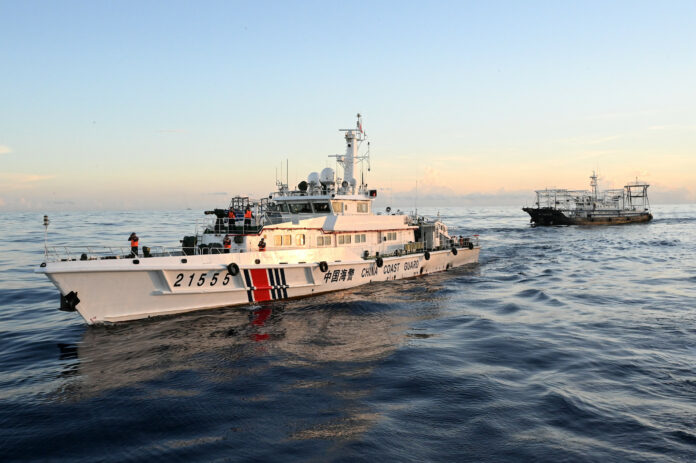China and the U.S. have conducted competing military exercises in the disputed South China Sea less than a month after Philippine and Chinese ships collided near a contested reef in the area.
Chinese state broadcaster CCTV and the Chinese military on Thursday published videos of “live fire drills” over the sea involving fighter aircraft, the release coinciding with American-Philippine naval exercises led by the USS Carl Vinson aircraft carrier.
Xerxes Trinidad, the chief of the Philippine military’s public affairs office, confirmed that two Chinese vessels had been “shadowing” the exercises “from a distance.”
Beijing criticized the U.S.-Philippine drills as “provocative military activities” with the allied forces “flaunting their military might.” Chinese Foreign Ministry spokesperson Wang Wenbin warned the exercises were “detrimental to management and control of the maritime situation and related disputes.”
“We urge relevant countries to stop their irresponsible actions and earnestly respect the efforts of countries in the region to maintain peace and stability in the South China Sea,” Wang said, vowing that Beijing will “continue to firmly safeguard its territorial sovereignty and maritime rights and interests.”
Newsweek has contacted the State Department by email to request comment.
The sea, and the competing claims therein, have become a major flashpoint between China and its neighbors, several of whom have bilateral defense agreements with the U.S. Washington, D.C. has repeatedly pushed back on Beijing’s efforts to establish dominion over the sea, conducting regular freedom of navigation exercises in coordination with local and international allies.
China, Vietnam, Malaysia, Brunei, and the Philippines all claim islands and reefs in the sea, largely grouped within the Spratly Islands, the Paracel Islands, and the Scarborough Shoal. The matter remains a divisive one for the Association of Southeast Asian Nations (ASEAN) bloc, in which Beijing has built significant influence.
Beijing has enforced its claims by building a network of militarized islands in the South China Sea and using its large navy—and a supporting irregular littoral fleet consisting of civilian fishing vessels—to confront competitors.
One such confrontation last month ended in violence when a Philippine boat and a Chinese Coast Guard ship collided near Second Thomas Shoal in the Spratly Islands. Philippine President Ferdinand Marcos Jr. said his nation remained “undeterred” by what he called Chinese “aggression and provocations.”
The China Coast Guard accused the Philippine boat of “deliberately colliding” with the Chinese vessel after “disregarding our multiple stern warnings.”
The Philippines has been drawing closer to the U.S. amid resurgent tensions with Beijing, with American troops returning to the country some 30 years after the closure of large U.S. bases there.
More broadly, Washington, D.C. is working to shore up and expand its regional network of allies—including South Korea, Japan, Australia, and New Zealand—in a bid to contain Chinese expansion in the South China Sea and deter Beijing’s designs on Taiwan.
China, meanwhile, has been leveraging its strong ties with regional nations like Cambodia to disrupt the combined efforts of its competitors to dispute Beijing’s actions in the South China Sea.
JAM STA ROSA/AFP via Getty Images
Last month, ASEAN foreign ministers issued a joint statement noting they “closely follow with concern the recent developments in the South China Sea that may undermine peace, security, and stability in the region.”
“We reiterate the importance of peaceful dialogue that contributes constructively to the promotion of regional stability and cooperation in the maritime domain,” the top diplomats said.
In October, President Joe Biden warned against any Chinese aggression in the South China Sea. “I want to be very clear: The United States’ defense commitment to the Philippines is ironclad,” the president said while welcoming Australian Prime Minister Anthony Albanese to the White House.
“Any attack on the Filipino aircraft, vessels, or armed forces will invoke our Mutual Defense Treaty with the Philippines,” Biden said.
Uncommon Knowledge
Newsweek is committed to challenging conventional wisdom and finding connections in the search for common ground.
Newsweek is committed to challenging conventional wisdom and finding connections in the search for common ground.


